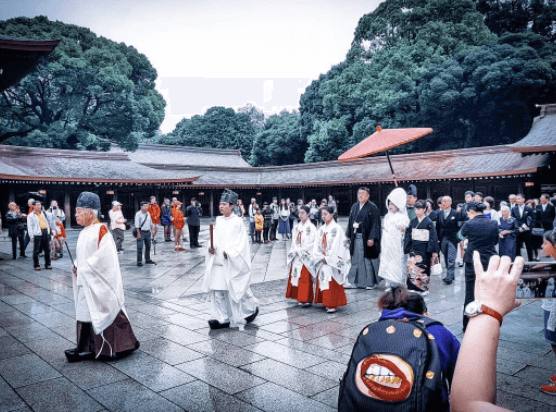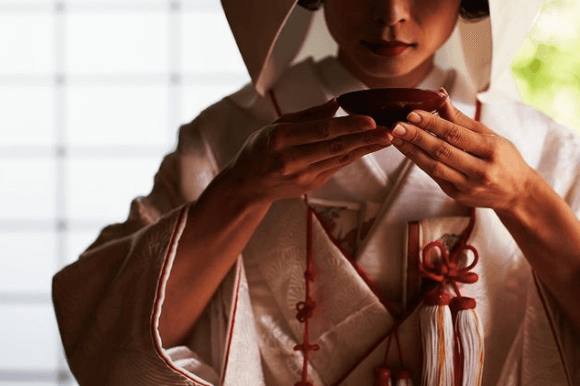If you’re wondering about how are weddings different in Japan, here is some insight into it.
Discover the unique traditions of Japanese nuptials in our exploration of how weddings in Japan differ from those around the world. From intricate rituals to modern adaptations, this insightful look offers a glimpse into the ceremonial elegance and cultural depth that define a Japanese wedding celebration.
Page Contents
How Are Weddings Different In Japan
They Have More than One Type of Wedding
Let’s talk about the first way of how are weddings different in Japan? Although it is the culturally rich country we are talking about, Japan, they were also not excused from being influenced by the West.
As popular as Shinto weddings might be in Japan, the Christian style white wedding supersedes it and accounts for the majority of the weddings there.


Sometimes, it is not because one of the spouses is a Christian, it is because it is the more fashionable kind. It all began after the glamorous screening of Princess Diana’s wedding in the 1980s.
Apart from Shinto weddings, other traditional Japanese-style weddings take place such as the Buddhist ceremony and the religious kind.
They are very rare and happen only among the rare orthodox family. I think the saying applies here: Born Shinto, Marry Christian and Die Buddhist.
Japanese Traditional Wedding Attire(s)
Let’s move to the next way of how are weddings different in Japan? Attires!
The aforementioned Shinto wedding has many, many stages for which the brides need to change their attire multiple times. Let’s start off with the main ceremony.
Any Shinto wedding, Shinzenshiki, will be held in a traditional shrine, where the bride and the groom will be standing in front of a Shinto priest, waiting for him to officiate and begin the ceremony.
Prayers are then offered. The stark white ensemble that the brides put together is known as the shiromuku. how are weddings different in Japan- got a reason now?
This complex, saintly outfit is meant to signify the purity of a woman as she is given to her husband. It also signifies cleanliness and the virginity of the bride.
Being clad in a plain outfit is directly symbolic of being wiped clean and going to the husband as a blank canvas to be written and moulded into the values and ideas of the husband’s household and life.
Importance of the Headdress In Japanese Weddings
The third way of how are weddings different in Japan is headdress, do you know about it?
The outfit is only complete with the white hood the bride wears as a headdress called wataboshi (The couples getting married the Christian way will continue wearing the see-through netted veil).
The reason behind the elaborate headdress is to hold back the spirits that seemingly linger in the long hair of the bride.
The second agenda is to hide her from everyone else so that the bride is only visible to the groom. This is how are weddings different in Japan.
Other accessories that are not very visible on the bride because of the elaborate-ness of the costume they wear are zōri sandals and tabi socks, along with a sensu holding fan, a hakoseko purse and a kaiken knife from the samurai period.
After the ceremony, it is customary for the bride to change into the traditional bridal kimono that is elegantly embroidered and embellished with bright red and flying cranes. It is called the iro-uchikake.
By dressing up in this beautiful attire, they are now getting ready for the reception. This brocade coat is adorned with cherry blossoms, apricots and other religious motifs.
The iro-uchikake is worn to bring good luck and health to the couple while wishing them prosperity and longevity. Hope this answers your question- how are weddings different in Japan as it’s one of the main points.
Only Person Named in the Invitation is Invited To Japanese Weddings – No Plus Ones
If you receive an invitation to a Japanese wedding, you must be really close to the family. How are weddings different in Japan- only single member unlike other places where the entire family is invited.

Quite often, only the closest friends and family members are invited to the actual ceremony where the rest of the guests are invited to the reception.
Quite opposite to what happens in Western weddings where more people are invited to the ceremony at the church, for all the shindig, and only the most beloved to the intimate reception.
Etiquettes Expected by the Guests in Japanese Weddings
Another way how weddings are different in Japan — if you receive an invitation, it is only for you. You can’t bring someone else with you. There is no such option as plus one.
If you have a wife or husband, they will be invited separately. It is common etiquette to comply with this. Surprise guests are usually not appreciated. Etiquettes are one of the reasons how are weddings different in Japan.
Gifts to the Couple
In this aspect too, Japanese weddings are different from the Western, even if they choose to have a Christian wedding. Here, people don’t go through the hassle of creating a gift registry.
Don’t make the mistake of taking a gift to the married couple. Saves you the effort of thinking about what to bring them. This is how are weddings different in Japan because of the gift culture.
The Japanese tradition calls for each guest, not family, to bring them a cash gift called gogushi.
A certain amount of money is put into a well-decorated envelope called Goshugi-bukuro. The amount of money you put into it, although, differs based on your relationship with the bride and the groom.
Typically, a friend or a colleague is expected to put in about 30,000 Yen, close to $350. This is another reason as to how are weddings different in Japan.
But if you’re their boss or a relative, you are expected to put in 50,000 to 100,000 Yen. The Japanese also think it is a bad omen to put in an amount that starts with 2 or 4.
Always make sure to put crisp new notes. The envelope is never given directly to the couple. Instead, there is a receptionist present at the wedding for such reasons.
No Wedding Registry – Goodies for the Guests
Japanese people consider it very important to thank their guests for their attendance. A mere wedding favour just won’t cut it.

Japanese weddings are quite extravagant, which extends to everything related to the wedding. These are also known as wedding souvenirs.
Bestaliproducts cover an article on buying cheap wedding favors in bulk.
In fact, the couple and their families spend a huge deal on these, because the family image means a lot. This is how are weddings different in Japan where every guest gets goodies, yay!
So much so that the guests are presented with a catalogue where they can pick their gifts from.
I knew it sounded wrong to say there is no registry! Here’s why there are limited guests (haha). But, still answered your question- how are weddings different in Japan.
Ceremonial Nuptials
As I said, Japanese weddings are quite elaborate. It doesn’t stop at the wedding and then followed by the reception.
Between the two events, after the bride and groom have just been wedded to each other, the couple goes through the san san kudo. It all began in the Edo period, back in 1600.
Sharing Cups of Sake
Here’s to answering your question- how are weddings different in Japan?
The literal translation of the phrase san san kudo would be ‘three three nine times.’ In the Japanese tradition, odd numbers are considered to be lucky, and nine is the luckiest of them all, so three times three makes nine.
The name is given to a ritual of drinking sake after the couple has been wedded by a priest. Both the bride and the groom, one by one drink a small amount of sake from three different cups.

There is a way to drink it and there is an order to drink it in. Each cup has its own significance and represents something that will only bring good things into the newly wedded couple’s life.
These cups are called sakazuki. More than cups, these resemble shallow sipping bowls that can hold a very small amount. They exist in three different sizes: small, medium and relatively large.
The correct way of drinking from them is to stack them on top of each other, where the smallest is on top and the largest on the surface of the table. Each cup has a meaning.
Drinking from the first cup is a form of showing appreciation to all the ancestors and the beloved elders of the family. The cup represents heaven. The second cup represents life on earth.
Drinking from the second cup is a form of respect for the vows the couple made to each other about unconditional love and care.
Finally, the third one, which represents humankind, is a prayer to all the gods for good health and fertility. This is how are weddings different in Japan because of their sake culture.
As for the matter of how to drink it: One never drinks the whole contents of the cup like it’s a shot in one go, it is meant to be taken down in three sips. Three sips from three bowls. Three times three is nine. San san kudo.
Reading Vows to Wrap it Up
After the ceremony, the couple goes up to the head of the shrine and reads out the vows prepared by the shrine. Vows make it different and answer your question of how are weddings different in Japan?
This is a reading done to promise and vow to the shrine gods and the bride and groom for the first time present themselves as one to the god.
After the reading, the bride and the groom, both say their names and titles out loud to ensure the legitimacy of this union and to abide by it.
The Inception of Reception(s)
When it comes to the reception, you might think here’s where the party ends, the celebration stops. But you are mistaken. You might even mistake them for Scottish party animals. But that is an exaggeration.
The initial reception is where the bride and the groom are set up on a pedestal to greet everyone and show themselves off as a married couple for the first time.
Another peculiar thing I found about Japanese weddings is that the ones closest to the bride, groom and their family members sit furthest from the pedestal.
It is more important for them to show respect to the elders, relatives and colleagues than it is to socialize with friends. This is one of the ways- how are weddings different in Japan.
Difference Between Japanese Weddings and American Weddings
- In Japan, it’s not appreciated to bring any extra members to the wedding who aren’t invited. Whereas, Americans welcome spouses and kids inviting someone.
- Japanese weddings are intimate, small, and formal whereas American weddings are extravagant, open, and informal with regard to customs, rituals, and invitations.
- Japanese couples getting married are expected to dress in Kimono and traditional attire while American weddings involve dressing in gowns and tuxedos.
- Brides in Japan are expected to wear a headdress during the wedding instead of a veil.
- In Japanese weddings, vows are read together to the God whereas in American weddings they’re read to each other.
- Japanese formal wedding ceremonies don’t involve any dancing whereas American weddings have dancing ceremonies.
How are Weddings Different in Japan: FAQs
What can I expect from a Japanese wedding?
Japanese weddings are divided into two parts, Kekkonshiki (ceremony), Hireon (wedding party) and Nijikai (the after-party). Only friends or colleagues are invited to Nijikai.
What should I wear to a Japanese wedding?
Japanese weddings don’t allow wearing animal leather as it’s a symbol of life and death. Females are also not allowed to wear sleeveless or two pieces as they’re considered bad luck. Females usually dress in kimonos while men dress in smart formals.
Should I bring a gift to a Japanese wedding?
It’s common to gift an envelope of money to the newlywed in Japan called goshugi. You can use new notes to give goshugi and odd numbers or exceptions with 8 are considered good. Typically guests give about 30,000 yen to 1,00,000 yen as goshugi.
How long is a Japanese wedding?
Japanese wedding ceremonies are usually 20-40 minutes which is followed by a 2-3 hours long reception.
How are weddings held in Japan?
Traditional Japanese wedding takes place in Shinto style and is held in Sinto shrines and under the guidance of a Shinto priest. It’s extremely formal and private.
Japanese Weddings are Fun!
Personally, I love attending weddings and being a part of different types of rituals, be it of any nationality but a little biased here because Japanese weddings are my favourite.
I hope you got to learn how are weddings different in Japan through this article, Next time you’re at a Japanese wedding, you can feel like a local!





